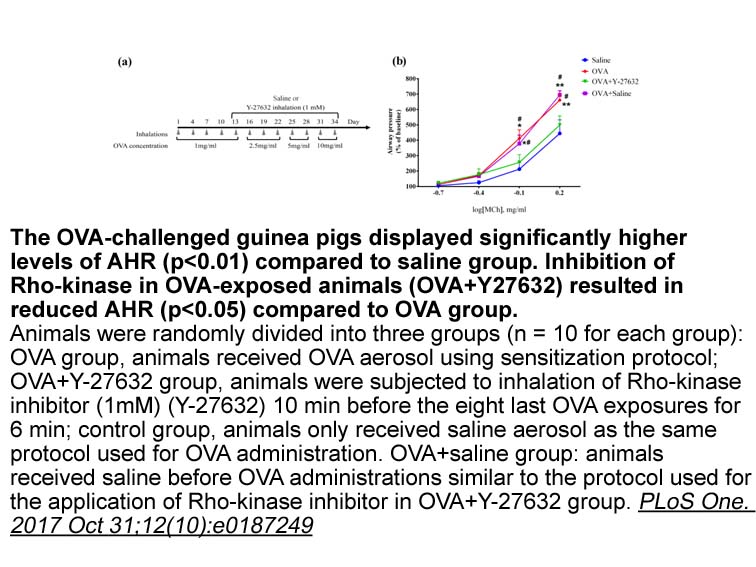Archives
Taking into account that Gr dysfunction is involved in
Taking into account that Gr dysfunction is involved in the molecular mechanisms underlying HPA axis disorder (Li et al., 2017b) and Gr activity has been reported to be lowered in patients with severe mood disorders (Rush et al. 1996) and in adult rats (Green et al. 2016), PFOS could alter HPA axis activity by inhibiting Gr gene expression in both amygdala and prefrontal Afuresertib of and stimulating it in the hippocampus, as well as by reducing the protein expression of this receptor in hypothalamus, prefrontal cortex and pituitary gland. Moreover, these alterations could lead to different mood disorders.
Conclusions and future directions
Conflict of interest
Transparency document
Acknowledgements
This work was supported by grants from the Ministry of Science and Innovation, Spain (AGL200909061) and from Xunta de Galicia (INCITE09383314PR).
Introduction
The neurobiology of stress-related mood disorders and related anxiety disorders has been extensively studied over the last decades to develop new strategies and effective therapeutic approaches to psychiatric diseases (Catena-Dell’Osso et al., 2013, Kormos and Gaszner, 2013). However, limited understanding of the pathophysiology of emotional disorders affects the development of novel therapeutic drugs (Catena-Dell’Osso et al., 2013). Thus, the progression of basic research with respect to the neurobiological mechanisms involved in mood disorders and anxiety is critical to support the development of reliable approaches.
Since corticotropin-releasing factor (CRF) was isolated and characterized as the major physiological regulator of the hypothalamus-pituitary-adrenal gland axis and was shown to be responsible for the coordination of the endocrine, autonomic and behavioral responses associated with stress (Vale et al., 1981), this neuropeptide has become a potential target for the treatment of stress-related mood disorders (Kormos and Gaszner, 2013). Although the highest concentration of CRF is found in the hypothalamus (Bittencourt and Sawchenko, 2000), this peptide is widely distributed within the central nervous system, including limbic areas (Cummings et al., 1983), which reinforces its involvement in the modulation of emotional responses (Anthony et al., 2014, Donatti and Leite-Panissi, 2011, Henry et al., 2006, Klemm, 2001, Radulovic et al., 1999). In particular, the central nucleus of the amygdala has one of the highest densities of CRF-immunoreactive neurons in the brain (Cummings et al., 1983, Palkovits et al., 1985, Swanson et al., 1983). The CRF neuropeptide exerts its biological activity by binding to two types of CRF receptors, CRF1 and C RF2 receptors (Hauger et al., 2006). More specifically, whereas a high density of CRF1 receptors is found in the anterior lobe of the pituitary, neocortex, hippocampus, basolateral nucleus of the amygdala and brainstem (Potter et al., 1994, Sánchez et al., 1999), CRF2 receptor expression is more restricted to subcortical structures, including the hypothalamus, amygdala, and brainstem (Lovenberg et al., 1995).
Fear-like behaviors are produced by intracerebroventricular CRF administration (Meloni et al., 2006, Radulovic et al., 1999), as well its administration into specific brain areas such as the amygdala (Daniels et al., 2004, Donatti and Leite-Panissi, 2011), the periaqueductal gray matter (Martins et al., 1997), the hippocampus (Radulovic et al., 1999), and the lateral septum (Bakshi et al., 2002). In this way, while antagonist CRF1 receptors have pronounced effects in normalizing stress-induced anxiety when CRF is released, CRF2 receptors appear be involved in the expression of both stress-induced anxiety and spontaneous anxiety behavior (Takahashi, 2001). Moreover, although preclinical data using CRF1 receptor antagonists in experimental animal models were unclear concerning their antidepressant activity (Nielsen, 2006), this receptor is considered to be possible target for the treatment of psychiatric diseases (Arborelius et al., 1999, Heinrichs et al., 1997, Reul and Holsboer, 2002). Additionally, previous study has shown that the activation of neurons that express CRF2 in the lateral septum promotes persistent anxious behavior, as evaluated by the light-dark box test, the open field test and the novel object test in mice (Anthony et al., 2014).
RF2 receptors (Hauger et al., 2006). More specifically, whereas a high density of CRF1 receptors is found in the anterior lobe of the pituitary, neocortex, hippocampus, basolateral nucleus of the amygdala and brainstem (Potter et al., 1994, Sánchez et al., 1999), CRF2 receptor expression is more restricted to subcortical structures, including the hypothalamus, amygdala, and brainstem (Lovenberg et al., 1995).
Fear-like behaviors are produced by intracerebroventricular CRF administration (Meloni et al., 2006, Radulovic et al., 1999), as well its administration into specific brain areas such as the amygdala (Daniels et al., 2004, Donatti and Leite-Panissi, 2011), the periaqueductal gray matter (Martins et al., 1997), the hippocampus (Radulovic et al., 1999), and the lateral septum (Bakshi et al., 2002). In this way, while antagonist CRF1 receptors have pronounced effects in normalizing stress-induced anxiety when CRF is released, CRF2 receptors appear be involved in the expression of both stress-induced anxiety and spontaneous anxiety behavior (Takahashi, 2001). Moreover, although preclinical data using CRF1 receptor antagonists in experimental animal models were unclear concerning their antidepressant activity (Nielsen, 2006), this receptor is considered to be possible target for the treatment of psychiatric diseases (Arborelius et al., 1999, Heinrichs et al., 1997, Reul and Holsboer, 2002). Additionally, previous study has shown that the activation of neurons that express CRF2 in the lateral septum promotes persistent anxious behavior, as evaluated by the light-dark box test, the open field test and the novel object test in mice (Anthony et al., 2014).